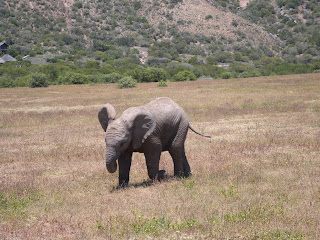We were supposed to dart the male lion on Friday in order to change his collar, but it got postponed yet again. We found them in an open spot which would have been perfect for darting, but it was as if they had a sixth sense that something was about to happen and moved off quickly into the thicket.
The vet was concerned that if the darted lion ran off into the thicket, it would be difficult to find him and also too dangerous with the female close by but hidden in the bush. Only the male lion wears a radio collar - which is neatly hidden beneath his mane - because the two of them are always together anyway. The plan is to try darting him again on Monday, using a carcass to draw both of them out into the open.
On the topic of carcasses, those of the wildebeest that the lions killed last weekend are now decomposing and smelling pretty bad. One carcass is right by a track that leads from one section of the reserve to another, so the safari vehicles have no choice but to pass within a couple of metres of it. By Friday it was teeming with maggots and flies. One of the guests complained that a fly from the carcass had landed on her and she was worried about any diseases it might be carrying. The reserve is incredibly responsive to any guest complaints so we received a call to consider options for how to handle it. There were discussions about whether the carcass should be moved or covered. The game ranger quite rightly pointed out that this is a game reserve and animals do get killed. It's the cycle of life. But some of the guests, who are accustomed to a 5-star pampered experience, seem to expect nature to be sterilised too.
As the options were considered, I prepared myself for the worst. I don't mind the digging. And I don't mind the pick-axing. But I didn't think I'd signed up to move a maggot-infested carcass. It was finally settled that we would just cover it up with a few reeds, which we duly did - holding our breath all the while. Ironically, this will slow the decomposition process down and leave the awful smell lingering around for longer. By covering the carcass up, many of the scavengers who would have feasted on it will now not see it. And the reed covering will add warmth and moisture to the mix, thereby increasing the stench further. As with every job, there are things you don't like doing. For me, it used to be filling in my appraisal form. Now it's dealing with smelly carcasses.
The high point of the day was coming across a herd of around 20 elephants on the other side of the reserve, including all members of the family, young and old. A couple of the males were using a termite mound to scratch themselves, by rubbing their backsides against it and then mounting the thing completely to reach their stomach. For one of them it didn't seem to be just about scratching, judging by the level of excitement it had engendered. Once we'd moved past the game ranger's predictable comment of "look, he's got five legs", I was not altogether surprised to learn that it's not just the male elephant's tail that is used to swat flies.
As we continued along the track, a larger group of elephants became annoyed with us as they decided to take the same route. We were on the receiving end of several of mock-charges. Apparently you can tell when an elephant is only mock-charging when they put their ears out, trumpet loudly and swing their trunks from side to side to kick up some dust. It's when they tuck their ears back against their sides and point their trunks straight out that you really have to worry. At that point, you've got a 6-ton beast coming at you who can cover 18 metres in one second. Either way, it's pretty intimidating and I don't think I'd be inclined to hang around to determine whether it's just a warning or they've completely lost it.




No comments:
Post a Comment